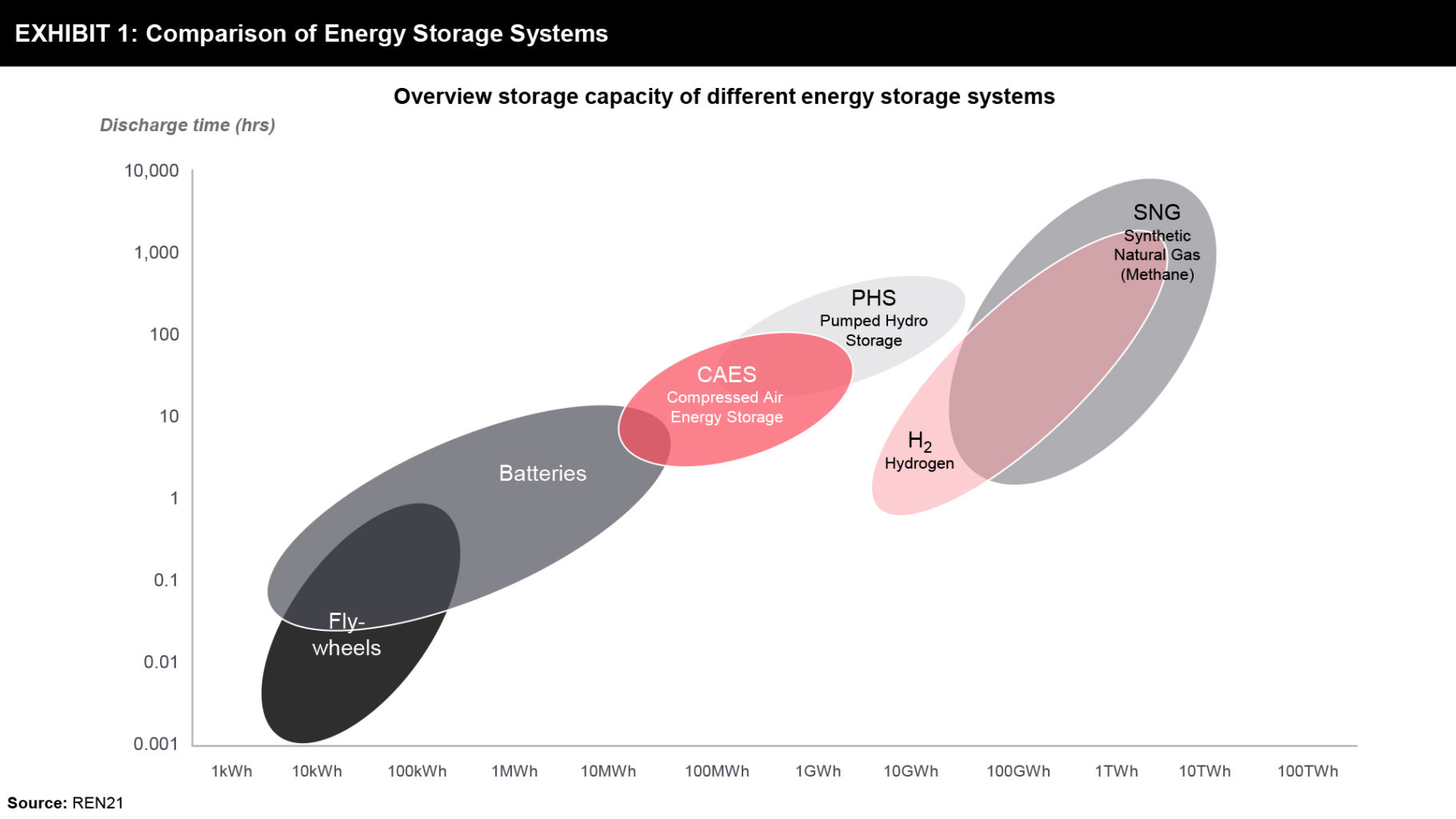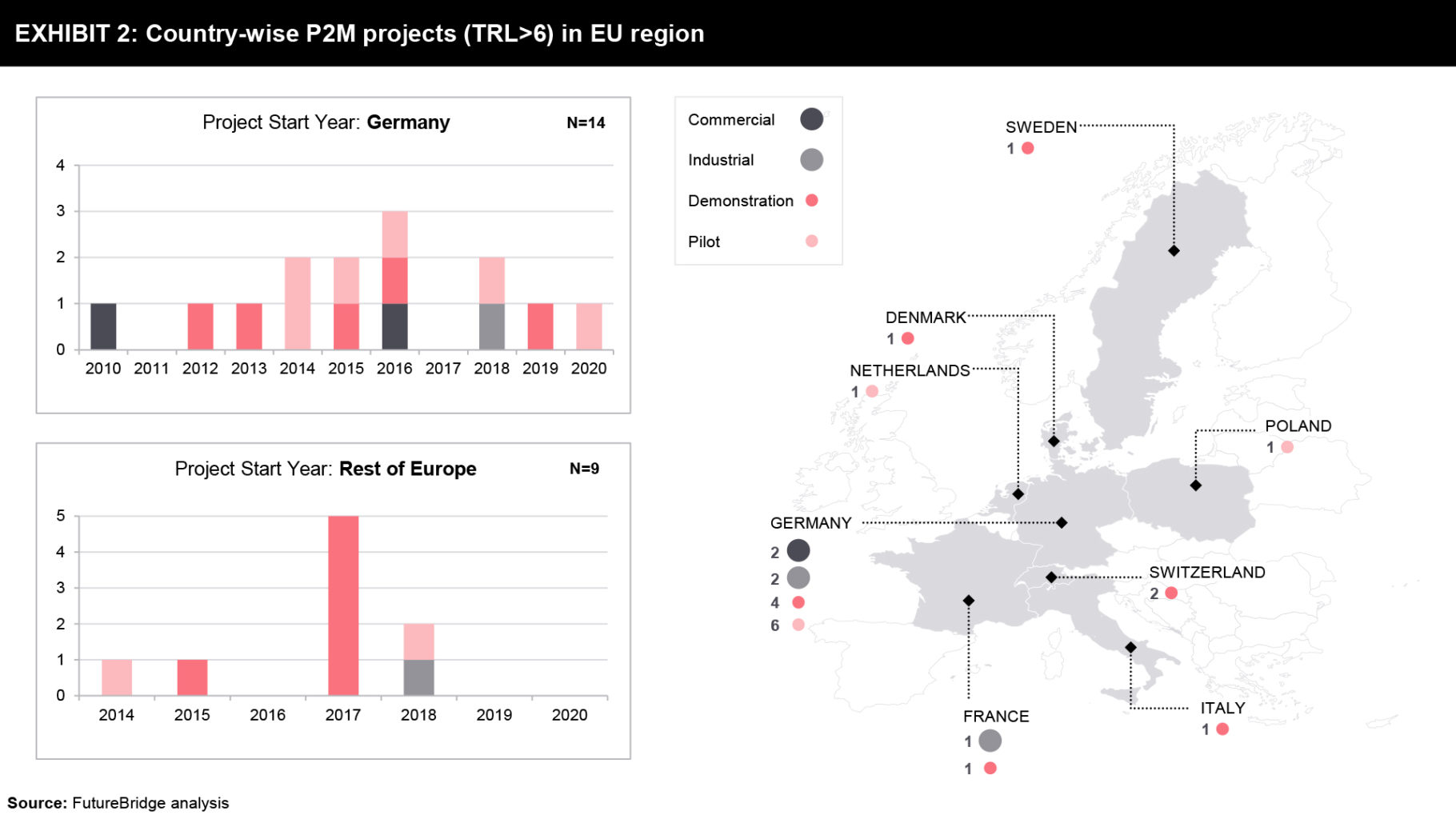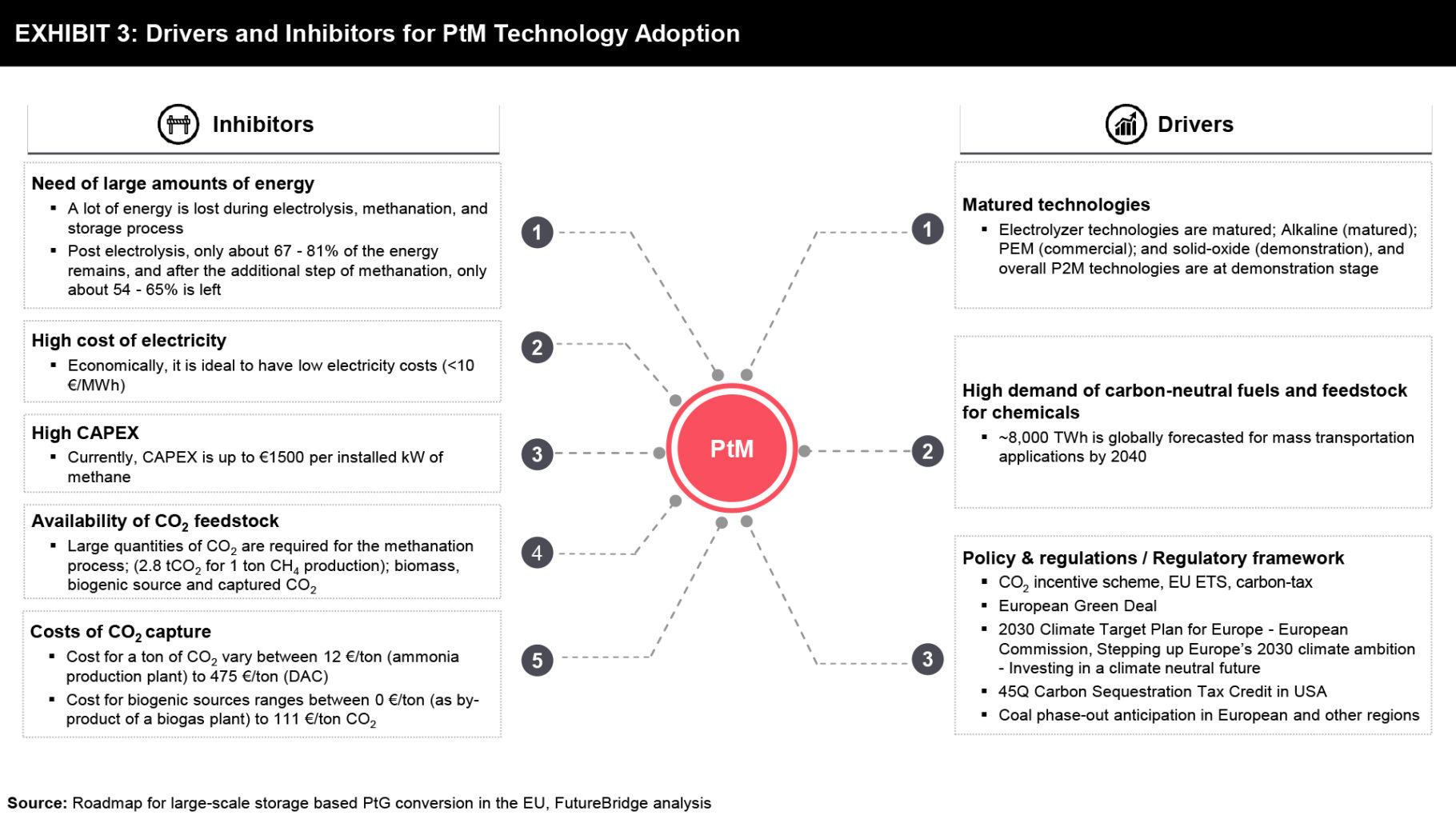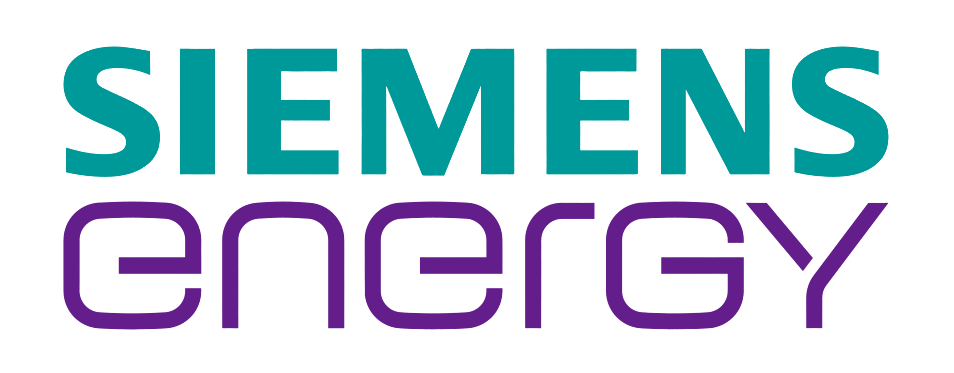Need for Decarbonization
Global warming has been one of the most challenging issues of recent times. According to Paris Agreement, the rise in global temperature needs to be limited to 1.5 Degrees Celsius (compared with pre-industrial levels) by the drastic reduction in emissions for limiting global warming. But how to achieve goals set by Paris Agreement? There is a widespread consensus that it can be achieved via components like energy efficiency, renewable energy sources including biomass, and carbon capture and storage (CCS). However, it would require a significant modification to the existing energy systems, especially for renewable sources due to its intermittent nature and the disadvantage of great variability over time and location.
One such modification is the use of complementary alternatives to overcome any fluctuations and provide flexibility to renewables. Efficient ways to store the surplus renewable energy is playing an important role in transitioning to the decarbonization of the entire energy value chain. Power-to-Gas is one such solution for storing surplus energy. Power-to-Gas (PtG) means the conversion of Power-to-Hydrogen, which can be subsequently used as an energy source itself or as a precursor for further compounds (e.g. methane, methanol, etc.). The basic process includes producing hydrogen via electrolysis from available electricity coming from renewables. And hydrogen can be converted to methane via chemical or biological methanation of carbon dioxide. Typical efficiencies for the process are 65–75% for Power-to-Hydrogen (electrolysis), 75% for hydrogen to methane.
Exhibit 1 represents a comparison of different storage capacities against discharge time and ranges of power


From the above graph, synthetic natural gas (methane) has a clear advantage in terms of storage time and range of power it can store over other similar technologies. Additionally, there is a huge potential for offsetting CO2 from the atmosphere or industrial gases as one of the raw materials in the methanation process.
There are several advantages of Power-to-Methane (PtM) conversion, like – use of existing infrastructure, the high energy density of methane compared with other chemical storage options, suitable long-term and large-scale storage, and the possibility of reducing CO2 emissions.
Current Challenges Faced
Even though the PtM route is one of the solutions to solve the intermittency hurdle of renewable energy production, there are several challenges that need to be overcome. PtM still makes up for a very small portion of energy storage solutions currently adopted across the energy domain due to challenges for widespread adoption such as:
- Efficient operations of electrolyzer when coupled with an intermittent source of electricity
- Long-period demonstration of methanation, especially when CO2 source is fluctuating
- Cost-effective extraction of CO2 as a raw material for methanation process
- From the CO2 use perspective; there are various applications favorable to methanation
- Challenges around integration and scaling
Focus on European Union
The European Union has a number of policies in place to support the reduction of greenhouse gas emissions, with the projected emissions reduction by around 45% by 2030 and 60% by 2050, compared to 1990. However, according to the recently published “Long Term Strategy, LTS”, these policies are not sufficient for the EU to contribute to the Paris Agreement’s temperature goals. According to the LTS study, energy storage is a key enabling technology for providing the required flexibility for the integration of renewable electricity into the grid.
In 2019, the European Commission presented the European Green Deal, setting up a framework for the deployment of innovative technologies and infrastructure, such as smart grids, hydrogen networks or carbon capture, storage and utilization, energy storage, etc. to reach net-zero global warming emissions by 2050. Hydrogen is considered an important link for meeting the Green Deal objectives.
Moreover, countries like, Sweden, Norway, Finland have policy frameworks and tax benefits in place for the adoption of methane for heating (including industrial uses) or transportation purposes. Similarly, there are funding programs in countries like Germany, Denmark, Netherlands, Spain, UK, and Poland for supporting PtM value chain technologies from ideation to commercialization. As a result of such policy frameworks and supportive funding programs, there have been significant efforts for the adoption of methane in national energy strategy and the EU is becoming the hotspot for research and development of PtM value chain technologies. In fact, more than 90% of projects with TRL greater than 6 are located in European countries.
Most of the efforts in advancing the research on the use of methane to store surplus energy are concentrated in Europe, with notable projects in countries like Germany, France, and Switzerland. Impressively, Germany leads by accounting for ~60% of the projects worldwide.
Exhibit 2 represents country-wise PtM projects (TRL>6) in the EU region


Few of the notable current PtM projects in the EU region:
- Audi e-gas project: The Audi e-gas plant is the largest industrial Power to SNG facility built in the world (6 MWe). It is based on the catalytic methanation of pure hydrogen and carbon dioxide in a single isothermal fixed-bed reactor. Audi e-gas project’s main goal was to reach commercialized PtG systems around 20 MW between 2015 and 2017, with efficiency above 80% with the help of the recovery of the extra thermal heat from methanation.
- Jupiter 1000: The Jupiter 1000 project is the first industrial demonstrator in France of Power to Gas with a power rating of 1 MWe for electrolysis and a methanation process with carbon capture. It uses a 0.5 MW alkaline electrolyzer and a 0.5 MW PEM electrolyzer to become the only project, in the medium term, to test the performance of those 2 electrolysis technologies under real conditions and on a real scale. The objective of the project is to store intermittent energies, by creating a link between traditional gas and electricity grids.
- BioPower2Gas: The first power-to-gas plant to utilize biological methanation across Germany. It processed the carbon dioxide contained in the raw biogas directly and did not require CO2 in high concentrations as in the case of chemical methanation. The main goals of the project were testing the electrolyzer and biological methanation with regard to stability for the long and short term, integrating the system fully into the biomethane plant, achieving a stable gas quality capable of being fed into the network, and demonstrating process-safe, dynamic operation.
- Store&Go: The STORE&GO project released the Roadmap for large-scale storage-based PtG conversion in the EU up to 2050. The primary objective of the STORE&GO research project is to demonstrate the viability of large-volume energy storage through Power-to-Gas technology in real-life applications. The project demonstrated three innovative Power-to-Gas (PtG) storage concepts at locations in Germany, Switzerland, and Italy.
- MethQuest: The project MethQuest aims to develop and investigate technologies that can be applied to extract methane-based fuels from renewable sources, use them in mobile and stationary applications, and quickly introduce them to the market. The project will look at different technical and economic aspects related to renewable methane in the frame of 6 subprojects – MethFuel, MethCar, MethPower, MethMare, MethGrid, and MethSys.
Drivers and Inhibitors
The driving factors for the PtM route include matured electrolyzer technologies, high demand for carbon-neutral fuels, and regulatory frameworks. Electrolyzer technologies for splitting water into oxygen and hydrogen majorly include alkaline (matured), PEM (commercial), and solid-oxide (demonstration). There has been a high demand for carbon-neutral fuels and feedstock for chemicals. Various policies like the CO2 incentive scheme, European Green Deal, and 2030 Climate Target Plan for Europe are aiding the PtM projects across the EU.
The inhibitors for the adoption of PtM technology are high CAPEX, high cost of electricity, and availability of low-cost CO2.
Exhibit 3 represents Drivers and Inhibitors of different energy storage technologies


Future Outlook
Despite relative early stages of development for PtM projects in the EU region, most of these projects have outlined future plans for commercialization or have outlined future goals of proving an operational success for higher capacity plants. FutureBridge is of the opinion that PtM can be an important link towards energy transition due to its integration capabilities with renewable energy sources. However, further research is required before the full-scale rollout of the technology.
Methanation projects are expected to be very important, with Europe likely emerging as the leader in driving the global uptake of PtM systems with the integration of gas networks and renewables for future energy systems.
Need a thought partner?
Share your focus area or question to engage with our Analysts through the Business Objectives service.
Submit My Business ObjectiveOur Clients
Our long-standing clients include some of the worlds leading brands and forward-thinking corporations.
- © 2021 Cheers Interactive (India) Private Limited. All rights reserved. FutureBridge ® is a registered trademark of Cheers Interactive (India) Private Limited.




































